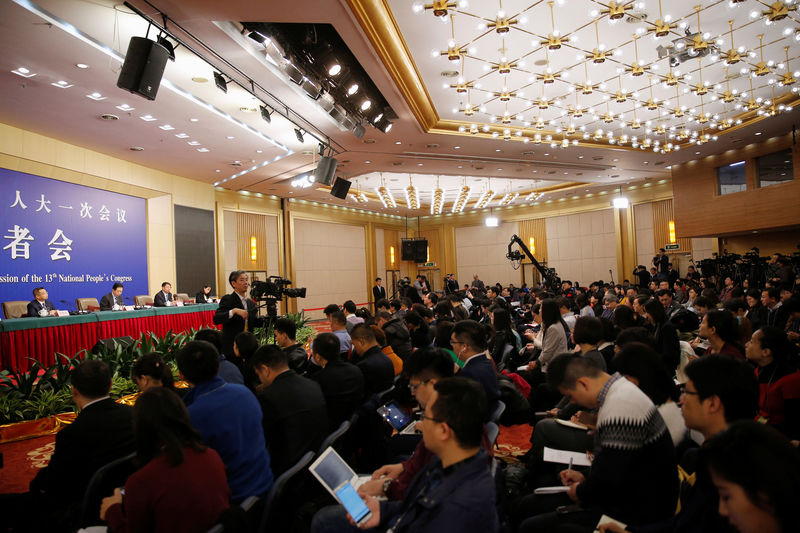 © Reuters. China’s Finance Minister Xiao Jie holds a news conference on the sidelines of China’s National People’s Congress (NPC) in Beijing
© Reuters. China’s Finance Minister Xiao Jie holds a news conference on the sidelines of China’s National People’s Congress (NPC) in BeijingBy Kevin Yao
BEIJING (Reuters) – China’s fiscal policy remains supportive for economic growth this year despite a rare cut in the government’s budget deficit target, Finance Minister Xiao Jie said on Wednesday, as markets worry over whether Beijing is considering scaling back stimulus.
Premier Li Keqiang announced on Monday that Beijing has cut the annual budget deficit target to 2.6 percent of gross domestic production (GDP) from 3 percent in 2017 – the first cut since 2012.
Li also did not give a hard target for money supply growth, while he and other officials have stressed authorities would step up their crackdown against riskier types of financing and high levels of debt, stoking concerns over how Beijing will be able keep growth steady.
Greater caution over spending and tightening monetary conditions could retard the pace of economic growth not only in China but globally. But Beijing has set the same growth target for 2018 as last year, at around 6.5 percent.
“I’m clearly telling everyone that the pro-active fiscal policy’s orientation has not changed, although this year’s fiscal deficit ratio declined from the previous year,” Xiao said at a news briefing during China’s annual parliament meeting.
That fiscal policy stance, which has been in place since the 2008-09 global financial crisis, will remain “relatively strong” this year, he said.
Most China watchers have described the deficit cut as largely symbolic, reinforcing Beijing’s intent to get financial risks under control, and have noted there are numerous other ways for the government to provide support and fiscal stimulus.
Indeed, Xiao pointed to a 550 billion yuan ($86.95 billion) jump in planned special bond debt issuance by local governments to fund key projects this year and a 30 billion yuan rise in central government budget for infrastructure investment.
Local governments will be allowed to issue 1.35 trillion yuan in special purpose bonds – debt which is repaid through returns on investment projects rather than fiscal revenue – in 2018, versus 800 billion yuan in 2017.
“Both figures indicate that we are doing additions and not subtractions,” Xiao said.
Adding to market confusion over how China’s budget plans square up, Premier Li has pledged to cut taxes for firms and individuals by more than 800 billion yuan this year, on top of fee reductions of 300 billion yuan, flagging slower revenue growth.
However, despite the lower deficit ratio, the size of the combined central and local government budget deficit is expected to remain unchanged at 2.38 trillion yuan this year.
Most economists already expected China will lose some growth momentum this year as its “de-risking” campaign pushes up borrowing costs and the property market cools. Escalating trade tensions with the United States also pose significant downside risks.
But Beijing has only missed a GDP growth target once in recent memory, falling just a whisker short in 2014.
Growth last year came in much stronger than target at 6.9 percent as hefty government infrastructure spending contributed to a building boom, while bank lending hit a fresh record and sluggish exports rebounded.
LOCAL DEBT RISKS
Beijing is widely expected to tighten the screws this year as it reins in risks, in particular focusing on local government debt. China will set reasonable quotas on municipal debt issuance and keep cracking down on “chaotic” debt financing, Xiao said.
“We will further standardize and strengthen local government debt management (and) continue to take measures of ‘opening the front door and blocking the back door’,” Xiao said, referring to shutting down covert financing practices.
Local government officials will be held responsible for debt raising activities, Xiao said, stressing he was fully confident such measures would prevent China from suffering systemic risks.
Such moves are likely already weighing on local infrastructure investment, analysts say.
Local government finances and burgeoning debt levels at China’s state-owned firms have been a source of concern for policymakers as the central government has rejected the view that it will implicitly offer guarantees to government financing vehicles if they get into trouble.
China’s total outstanding government debt stood at 29.95 trillion yuan ($4.73 trillion) at end-2017, which was equivalent to 36.2 percent of gross domestic product, down from 36.7 percent in 2016, Xiao said.
Authorities expect no significant changes in the government debt ratio in the coming years, versus the level in 2017, Xiao added.
China has capped the outstanding local government debt at 21 trillion yuan for 2018, according to the annual budget report.
Source: Investing.com



























